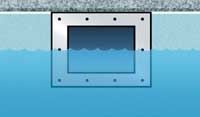

use this technique not to make the pool look better, but to save water for the customer. Water has become a precious commodity lately. On normal automatic-cover installations, the waterline sits at the same level as the cover dam (shown here). As people swim, water goes up and spills over the cover dam into the cover box. Then it just drains away. People are losing hundreds
of gallons of water just through displacement.
 That’s why I lower the water level by 2 inches in all the automatic-cover pools I build (shown, right). This will leave the water 2 inches lower than the cover dam, so it doesn’t go over the dam every time someone enters the pool.
That’s why I lower the water level by 2 inches in all the automatic-cover pools I build (shown, right). This will leave the water 2 inches lower than the cover dam, so it doesn’t go over the dam every time someone enters the pool.
To do this, of course, you have to lower the skimmer 2 inches. You’ll need the skimmer throat to be 2 inches taller. You also need 2 inches or more of waterline tile, depending on which tile the client chooses.
I usually try to steer them toward a 2-inch or 3-inch tile, so we end up with a tile line that’s 8 or 9 inches high, rather than 6 inches. I try to avoid using a 6-inch tile: We’d need to stack two of them for a 12-inch waterline, which looks really funny.
By dropping the water level 2 inches, you’ve now exposed 2 inches of the dam wall. If you use plaster, you’ll need to put tile on the face of the cover dam; otherwise, you’ll have exposed plaster. We just continue the tile line across the cover dam, making sure we get at least 4 inches of tile on there. It’s just a matter of lining up with the bottom of the waterline going around the rest of the pool.
From a construction standpoint, this is no big deal. The steel just has to dip down a little bit lower at the skimmer throat. My steel guys and plumbers know that we do this on our automatic-cover pools.
Another advantage is that you don’t have to worry so much about drainage from the box. This helps when you don’t have very good drainage out of the cover box initially. Drainage is still important, but it’s not as critical because you don’t have hundreds of gallons of water going into it — just rainwater and whatever sits on top of the cover and dumps into the box. Drainage is strictly there to protect the drive mechanisms.